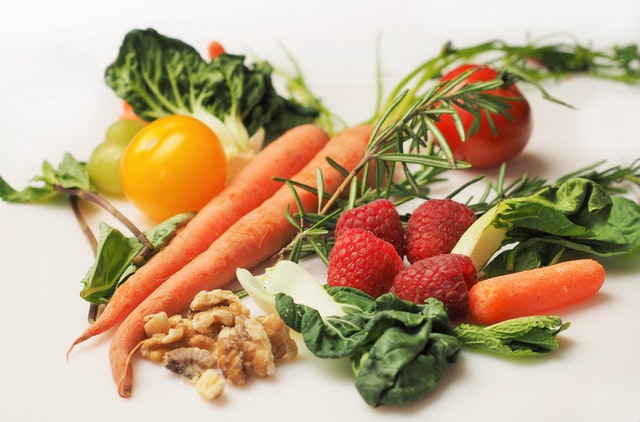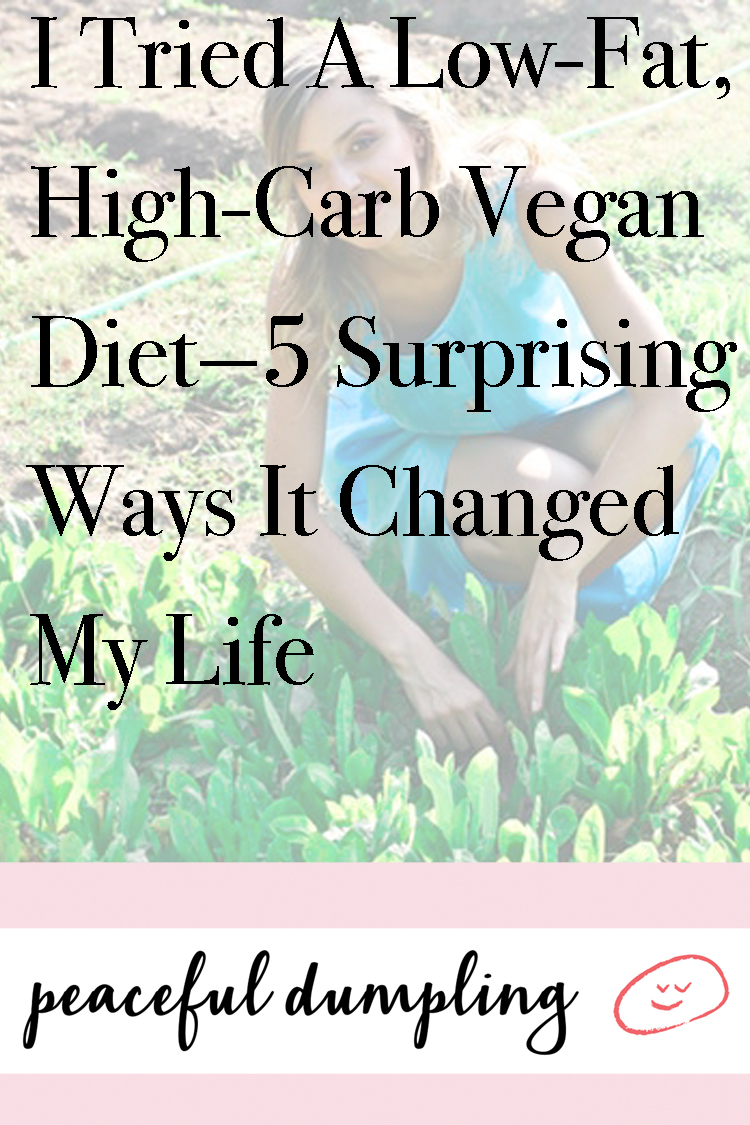
My low fat vegan diet has changed my health, and I’m never going back.
The health benefits of a vegan diet is now an established fact with countless examples and studies around the world: The famous China Study, the natives of Papua New Guinea whose caloric intake is 90% sweet potatoes (!), even those inspiring people whose lives were transformed before our eyes here in the U.S. in What the Health. What “veganism” doesn’t specify, though, is where those non-animal-based foods come from. One could technically be vegan while subsisting on some very non-food, unhealthy foods like high fructose corn syrup, soy isolate protein, the mysterious lupine steak, and other such processed ingredients that are more and more common as vegan alternatives for animal-based foods.
A more specific synonym for a vegan diet that truly benefits the health of the body and planet is a “whole foods, plant-based diet” (WFPB), as advocated for by the T. Colin Campbell Center for Nutrition Studies. For the past several weeks I’ve been enrolled in their online e-course through Cornell University, learning about the ways that choosing plants in their natural form for every meal can prevent, stop, and reverse diseases including our nation’s leading killer, heart disease, preserve land and marine resources, and overall enrich our health. But the most fascinating information has been the proof that the WFPB diet isn’t about pounding down nuts and legumes as a way to make up for the protein lost from animal products. Instead, as evidenced by the China Study, optimal health and longevity come from a caloric ratio of 10-12 percent protein and less than 30 percent fat (the China Study documented that the healthy locals consumed 14.5 percent fat). That leaves around 60-70 percent for, you guessed it, carbs. And not just any carbs, but whole-grain ones—i.e., the ones full of gluten like 100 percent whole wheat, barley, and rye (unless you have Celiac or another verifiable wheat allergy).
Before your mind is completely blown, remember that fruits and vegetables are mostly carbohydrates. They are made of sugar, which breaks down into glucose in the blood, but also high amounts of dietary fiber that help to slow down its digestion and ultimately stabilize blood sugar levels (this is the process behind the Glycemic Index). Fiber is also found in whole grains, but it the process doesn’t work as well when grains are milled or otherwise broken apart (aka juicing), since the casing that contains the digestive enzymes are no longer protected for slow release in the body. Conversely, fat and protein intake has been shown to have immediate effects on insulin and cholesterol, so much so that even in healthy young adults who were engaged in high-intensity cross-fit exercise, which naturally slows cholesterol production, saw a huge spike in their cholesterol on while on a paleo diet.
When I first learned this information, my mind was pretty blown. As a relatively healthy person with no serious medical conditions whereby a low-fat diet would be beneficial for weight loss or other measures, I had no reason to suspect that my vegan fat sources (mostly nuts, nut butters, tahini, and olive oil) were doing me harm; in fact, I’d been taught that the body needs a relatively large amount of fat to better digest carbs and ultimately protect the coating of nerves in the brain. But I decided to undertake a study of my own to see how it would feel to embrace the carbs I thought were the devil. Limiting myself to a single serving of nuts per day (~150 calories spread between breakfast and lunch but not at dinner) and not making a conscious effort to add protein sources (like tofu or tempeh), I enjoyed as much fresh produce, but also previously off-limit foods like rice and potatoes, as I wanted to feel full. By the end of my five-day trial, I couldn’t believe what had happened.

Results of my 5-day High Carb Low Fat Vegan Diet experiment
- I ate more, but didn’t binge: In the past, eating mostly vegetables and fruits would leave me feeling depleted and hungry shortly after finishing a meal. This time around, the balance of whole grains with produce allowed me to both better sense satiety signals and stay fuller for longer. For instance, at dinner I allowed myself a whole sweet potato (about 1 cup cubed) to “make up” for the calories I otherwise would have had in a fat-based sauce or dressing. While it’s true that potato had more volume than a few tablespoons of sauce, it also had the magic f-word, fiber, to provide a steady release of energy instead of a big, heavy hit that fat can deliver.
- I spent less money and bought no packaged foods: Lately, I’ve been struggling to stay on top of weekly grocery shopping, meaning by Thursday I’m spending a half hour trying to figure out the best place for a vegan lunch on Yelp and then needing to run out for a snack around 4 PM. Since most prepared and packaged foods, especially of the health/granola bar variety that purport nutrient density, are full of fat and oil, I had to turn more frequently to fresh, whole fruit for snacks and last-minute meals. At first, it seemed less convenient to need to buy (and eat) multiple whole fruits a day, on top of not being able to roast or sauté veggies in any amount of oil or even incorporate packaged soy products like a block of tofu. But then I realized I still had cash in my wallet at the end of the week, despite my paying cash at the farmer’s market and fruit stand for a whole broccoli jacket (that became 5 servings of soup) and week’s worth of apples and bananas. And how much emptier my recycling bin was without all those non-whole foods, and yet how flavorful the food still was. At the peak of produce season here in the northeast, stone fruits like nectarines and juicy, off-the-vine tomatoes need next to nothing to be delicious—who was I to complain if nature wanted me to save money on her offerings?
- I had more energy: Movement, in the form of intentional exercise and foot-based transportation, is a big part of my life and work. But even on my healthy and “balanced” diet, I had days and weeks when waking up felt like a drag, and by the end of the day, I literally had to drag myself to spin class or yoga let alone try to focus on evening work projects. The movement that once felt easy was a lot of work until I literally gave myself more energy with carbs. And even though I was still tired at the end of the day, I found myself sleeping better and waking up with a moderate appetite, instead of feeling slightly hung-over after trying to “replenish” my workouts with protein and fat.
- I got regular (and happier): Regular digestion has been a struggle for the better part of my life and this summer in particular. Although I’d been employing other remedies, including a combination of doctor-ordered Chinese herbs, to rectify the problem, the high-carb switch gave my gut a big kick in the butt. Carbs, especially FODMAPs, are essential to feeding our gut flora that allow for proper digestion, so when we starve those good bacteria they no longer break down food or support proper immune function. Once I upped my carb intake, especially prebiotic olygosaccarides like onion, wheat, and asparagus, things started flowing again. And a happy gut makes for a happy woman!
- I lost weight: By the end of my week, I was feeling noticeably lighter and more energized but chalked it up to improved digestion and more sleep. When I stepped on the scale, though, I realized I unintentionally shed a few pounds that had been stockpiled during the summer heat. The weight-loss wasn’t drastic or continuous, but it seemed to reflect a bit of a starvation mode since before, my body wasn’t getting enough carbs and had to hold onto what I did eat to protect itself.
For me, this circumstantial evidence provides ample backing to the research about the value of a WFPB diet with minimal fat and protein. But you should always discuss with a physician or nutritionist before embarking on a new diet, especially for medical conditions. Eating more plants, however, is never a bad thing—especially when they’re local, organic, and kept intact as nature delivers them.

Have you tried a low-fat, high-carb diet?
Also by Jennifer: Guess What, Your Gut Affects Your Personality–& Other Facts About Your Insides
Related: I Was Overweight & Chronically Sick Until *This* Diet Transformed My Life
I Tried Obesogen-Free Diet & Results Were Almost Instant—Here’s How To Implement
This article was first published on August 22, 2018 and most recently updated on October 2, 2019.
__
Photos: Pexels.com




